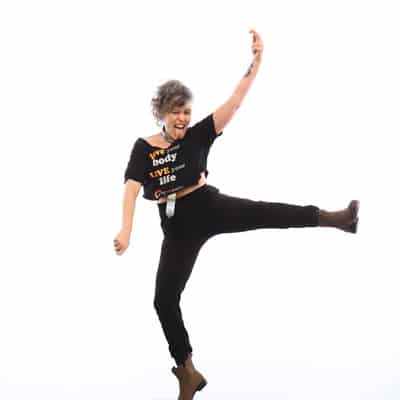Queer Fertility is a Body Positive Journey
posted by MD Spicer-Sitzes / January 15, 2019

The World Health Organization (WHO) defines infertility as “a disease of the reproductive system defined by the failure to achieve a clinical pregnancy after 12 months or more of regular unprotected sexual intercourse.” Regular, unprotected sexual intercourse? Obviously, they didn’t have queer* families in mind when creating this commonly used definition.
I am not considered infertile by this definition, but when my wife and I decided we wanted to have a baby in early 2017, I was forced to be diagnosed as such. I was also required to take medications that I didn’t need in order to even be seen by a reproductive endocrinologist, just to begin the family planning process. The diagnosis is now part of my permanent medical file, as are the physical, emotional, and financial impacts of the medications I had to take. Not to mention the impacts of the rest of the process my wife and I have been struggling through over the past two years.
What message is being sent when people have to be diagnosed as infertile simply for being in a relationship that isn’t heterosexual and/or cisgender? While some queer folks struggle with infertility like the rest of the population, the reasons queer people seek help creating a family more often have to do with needing access to sperm, or access to a uterus and eggs. Infertility is serious and deserves its own field. So does queer family planning.
We need more medical professionals that are empathetic to the differences between true infertility and queer family planning, and who consider the urgent need for queer-friendly, Body Positive practices when treating queer patients.
The goal of Intrauterine Insemination (IUI) is to increase the number of sperm that reach the fallopian tubes, hopefully increasing the chances of pregnancy. The average successful IUI takes somewhere between 3-6 cycles or more, and many people choose to move to an in-vitro option (IVF) by cycle 6, if they can afford it. Each IUI cycle can cost around $2,000 ($15,000 or more for each IVF, even with insurance). Added testing for infertility treatments can be through the roof, not to mention the time needed to take off work for sometimes multiple appointments a week. I am grateful that I work for an ethical organization like The Body Positive, that I have colleagues who value radical self-love, and that I’m fortunate enough to be able to access this process, despite the challenges. Many people cannot afford the industry-side of fertility treatment, and that is another major issue.
I am encouraged by the brave people who spend years undergoing infertility treatments. My wife and I have been at this process for about two years (so far). It’s exhausting. So it’s comforting to know we aren’t alone. I also have deep respect for those who opt out of having kids at all. The global human population is rising fast, and there’s a lot to consider on how the earth will sustain future generations. Further, over 400 thousand kids are in the foster system in the United States. It can be a difficult process, especially for queer couples who, depending on where they live, still run up against homophobic legislation and belief systems, that believe a child is better off in foster care than with a queer family. Some biological parents don’t want to surrender a child to queer adoptive parents. In many foster-to-adopt or private adoption information sessions, the question of whether to mention that you are a queer person/couple or not is covered at length. Society often assumes queer people should not have children, that it’s not natural or spiritually moral.

MD Spicer-Sitzes (the author, left) and their partner Cathy
The entitlement that people feel to impose their beliefs onto a queer couple trying to have a baby doesn’t stop there. One nurse told me that she wasn’t sure if the medical procedures for Cathy and me were the same as they are for a “normal” couple. Another referred to her as my “friend.” These microaggressions make an already painful experience worse.
In my work with The Body Positive, I’ve been witness to and a part of countless conversations about our individual and collective experiences of marginalization, and the experiences that contribute to our unique beauty. Authentic body positivity is about justice. Body positivity acknowledges the truth that beauty is diverse and wide. My beauty includes my desire, as a queer, gender-fluid individual, to have a family with my wife. It’s a vision of mine to see more Body Positive, queer- and transgender-friendly family planning services, especially in fertility and reproductive health clinics. In order to make change like this happen, we need people to understand what true body positivity is, and just how much it is needed if we want healthcare to be equally accessible to all.
Whether we want to stop medical diagnoses based on BMI, advocate for wheelchair accessibility everywhere, challenge racism in institutions, or advocate better ways for queer people to create families, body positivity is at the core.
There’s a myth around equality that I think true body positivity debunks; the myth that we are all the same. We are not all the same, and these differences should be celebrated, not denied. There is not a singular way for body positivity to exist, however, there are some common connections at play here and it brings me hope to see more and more people recognizing the great impact that a practice of body positivity has.
Perhaps the secret to overcoming our isolation and fear about the queer family planning process includes first working to dismantle the social taboos that exist for (all) people who experience an infertility diagnosis. We then need to also dismantle taboos around gender, sexuality and queer parenting, and that takes community. While it’s true that there can be damaging messages on social media; it can also be a haven of support. I often think about the fifth core Competency of the Be Body Positive Model, Build Community, and reassure myself that I have a giant community, inclusive of Body Positive and queer couples and individuals who want and/or have children. My community has given me so much hope, especially as this has been, until now, such a private process for my wife and me.
There is still so much we don’t know about the universe, the earth, the human body; the mystery does not imply that we shame it. Queer pregnancies, and queer bodies in general are not unnatural, they just need some extra support sometimes, like everyone. Needing a doctor’s help to conceive should not be a stigmatized experience. It’s something many people go through, queer or not. Being queer doesn’t make our desire to have a family any less valid and it doesn’t make us any less deserving to try. What I always come back to is the expansive quality of love that Cathy and I feel—and we’re bursting at the seams with it—which seems like the most important part of parenting of all. And we are ready to share that love with a child.
***********
If you work with LGBTQ+ communities, and are interested in learning a Body Positive approach, ask me about my workshop: Queer Bodies: Applying the Be Body Positive Model to the LGBTQ+ Community: md@thebodypositive.org
*The author uses the term ‘queer’ in this article as an umbrella descriptor for non-hetereosexual and gender-diverse people.
 Md spicer-sitzes
Md spicer-sitzes
MD Spicer-Sitzes is Associate Director of The Body Positive and a volunteer with Building Allies, and organization that works to build active allyship. MD holds an M.A. in Urban Sustainability and also enjoyed studying Queer Theory, Marine Biology and Solidarity Economics. MD loves growing and making food for friends and family, hiking, storytelling, research, and a successful direct action protest. They live with their wife Cathy, and two rambunctious bunny rabbits in the East Bay.
MD Spicer-Sitzes
MD Spicer-Sitzes is Associate Director of The Body Positive and a volunteer with Building Allies, and organization that works to build active allyship. MD holds an M.A. in Urban Sustainability and also enjoyed studying Queer Theory, Marine Biology and Solidarity Economics. MD loves growing and making food for friends and family, hiking, storytelling, research, and a successful direct action protest. They live with their wife Cathy, and two rambunctious bunny rabbits in the East Bay.
